
U svojim romanima i naročito futurističkim ilustracijama nastalima 1880-ih Robida se pokazao boljim prorokom od Julesa Vernea: LCD televizor, roboti, masovni turizam, medijski pokriveni ratovi, društveni napredak žena...
“Albert Robida (1848–1926) wrote an acclaimed trilogy of futuristic novels. He proposed inventions integrated into everyday life and imagined the social developments that arose from them: social advancement of women, mass tourism, pollution, etc. His Téléphonoscope was a flat screen television display that delivered the latest news 24-hours a day, the latest plays, courses, and teleconferences.” - Wikipedia
http://www.tumblr.com/tagged/albert%20robida?before=22

Title Page - "The Twentieth Century" (1883) - Albert Robida

Future Paris at Night - Albert Robida (1883)

Future Public Safety via the Air Police - Albert Robida (1883)




The Future Holds Telephones - Albert Robida (1883)

War Correspondents of the Future - Albert Robida (1883)

Shocking! Women in the Stockmarket! - Albert Robida (1883)

Selecting A Mate in the Future - Albert Robida (1883)

Shocking! Women in the Stockmarket! - Albert Robida (1883)
Inconceivable! Women Lawyers of the Future - Albert Robida (1883)

The Revolution of 1953 - Albert Robida (1883)

http://ximenez.tumblr.com/post/27786667509/la-vie-electrique-by-albert-robida-1890

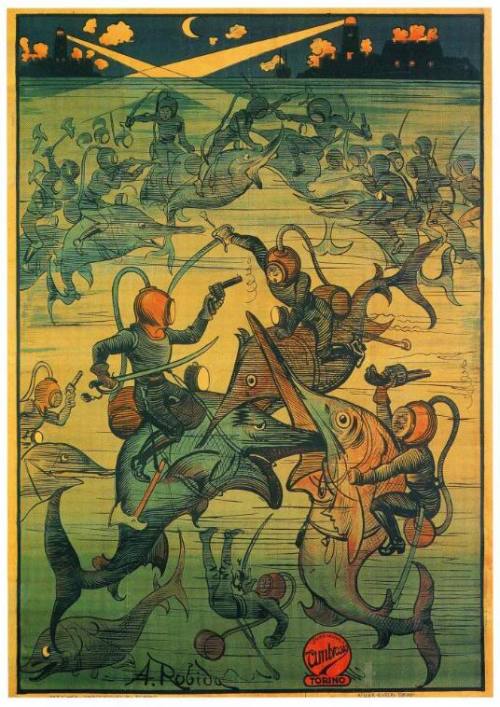

Albert Robida's The Twentieth Century, as pointed out by P. Willems in his lengthy and rather erudite introduction, and John Clute in his Excessive Candour column, is an important work of early science fiction. Important in that Robida, as possibly the first dedicated science fiction illustrator, gives us something part ways between a mere illustrated novel and a graphic novel, with illustrations that go far beyond depicting the mere text, adding visual information and details which expand one's view of the world he creates. At the time he wrote, Robida's work, while popular, was largely overshadowed by that of Jules Verne, who was roughly 20 years his senior. Indeed Robida's first novel length work of fiction, Voyages très extraordinaires de Saturnin Farandoul dans les 5 ou 6 parties du monde, et dans tous les pays connus et même inconnus de Monsieur Jules Verne was largely a spoof of Verne's Voyages Extraordinaires series, with even an appearance by Capt. Nemo in the first part of the book. However, where Verne's romans d'anticipation were truly hard SF, with a sometimes didactic exposition of the science to back up the futuristic gadgetry, he showed little concern of their possible influence on society -- except perhaps in his posthumously published Paris in The Twentieth Century (1996). In contrast, Robida's prediction of 1952, as seen from 1882, completely ignores the physics and inner workings of the technology he presents (everything works through the miracle of electricity), focusing more on how society deals with the technology, and adding a great deal of satire and outright humor, generally absent from Verne's SF works (although Verne's non-SF title Kéraban le têtu is quite humorous).
In some ways Robida's view of the future is closer to our current reality than Verne's, perhaps because he extrapolates the natural evolution of the society of his time, rather than that of its technology. Some (Nicholls and Angenot) argue whether Robida's 1952 is just an extension of 1882's technology or true prescience. Certainly, underground compressed air-powered bullet trains are a direct expansion upon the poste pneumatique, a high speed compressed air driven mail distribution system inaugurated in Robida's lifetime. Similarly, personal dirigibles are clearly a product of their time, though he does have some bearing advertisements. However, Robida also projects full women's equality, media-friendly choreographed revolutions, flat-screen television (the téléphonoscope) with multi-channel cable TV, live telecasts from the front of distant wars, ultra-liberal prison reform, airborne restaurants and casinos, revisionist historical documentaries, and even ultra-condensed literature (see here for this very thing today).
As for the novel itself -- like any good utopia or distopia, don't expect any plot, just some characters serving as a vehicle to view the projected society. As such, The Twentieth Century is a guided tour to 1952, with the thin premise of a multi-millionaire's "dumb blonde" niece trying her hand as a defense attorney, a politician, journalist and financier as she tries to decide what sort of career to take up -- ultimately she gives just gives up and marries. So why bother reading The Twentieth Century? One because it is, for all the subtext Dr. Willems might read into it in his Introduction, a wonderfully light-hearted, whimsical, funny book, lampooning everything and everyone in sight -- it is even funnier when read in the original French. And secondly, for all that Robida was stodgy and straight-laced in his personal life, his illustrations (see 1, 2) are informed with all his ebullient Gallic wit and humor, and are worth the price of admission in of themselves. His fish-like dirigibles, while perhaps reminiscent of vehicles in some of Hieronymus Bosch's weirder paintings, are whimsical and goofy, and one just can't help but feel the whole thing is a grand farce. Certainly, Robida's first novel, ...Saturnin Farandoul... is one long screw-ball comedy-adventure, and one can certainly see some of this in The Twentieth Century.
This first English translation, which from a few comparative samplings of the French vs. English texts is very well done, includes illustrations from a number of the original French editions (though unfortunately none of the original colour illustrations), as well as some of Robida's other artwork. Philippe Willems' introduction, while well researched and clearly presented, stands at close to 60 pages. With section subtitles like Hermeneutic Heterogeneity and Postindustrial Positivism, along with 30 pages of endnotes and bibliography, such material might frighten off some, but be advised that the novel itself is much more Monty Python than Woody Allen. - Georges T. Dodds
Robida, The Future Man!
By Remy Chevalier
Ah, Paree… CanCan Girls, Pigale, La Belle Vie! This once great city was the hub of nations at the turn of the century before New York took over the role of planetary capitol. Today Paris is a crossroads for African and Eastern cultures. It’s changed a lot, to the point where many Frenchmen don’t recognize it anymore and are rebelling against the multiracial soup it has become by lending ever increasing support to right wing fanatics like Le Pen and his policy of hate. Except for wine, cheese and a few fashion houses still not under the tutelage of British designers, France has lost its edge as the technological wonder of the world. Gone are the days of incredible world’s fairs and mad rushes to the patent office. The French have decided to rest on their laurels, protect their language from a nebulous invasion of Americanisms, despite the fact there’s just as many French words in the English language as vice-versa!
But it hasn’t always been that way. Perhaps two all consuming wars took their toll on the French spirit of innovation and exploration. Maybe the French have lost their nerve, opting instead to stand passively by as a corrupt international mafia shoves nuclear power down their throats and over charges its citizens for Internet access by a factor of ten for fear the Yankees would take over their brains!
Before two bouts of insanity with the Germans, the French made miracles happen. As I walked around the Left Bank last fall I discovered a little bookstore of interest to all WEX readers. It’s called the Monte Cristo after the famed traveler. It’s on rue de l’Odeon, a street full of old and odd bookstores, a favorite hangout for students. What makes this one special is the books it sells. All leather bound and gold leaf first editions of books by Jules Verne. When you walk inside it feels like climbing on board Captain Nemo’s private study. The owner, a chain smoking intellectual by the name of Jean-Marie Embs, revels in the lore of this not so distant past when France anticipated all wonderful futures, before the rug was pulled from under those dreams.
Not too intimidated by his presence, I brought up the recently rediscovered work by Jules Verne Hachette published last year, the folks who bring you ELLE, George and a multitude of car magazines. In case you don’t know the story, Jules, lets call him Jules for the sake of brevity, had submitted a first novel that his publisher promptly turned down, as publishers often do just to let you know who’s boss. Instead of reworking it until it met expectations, he buried it and wrote a brand new one, the famed “Five Weeks In A Balloon”. It wasn’t until our decade that someone dug up this first attempt again, only to discover it was all about Paris in 1960, a hundred years ahead of schedule. Jules was 35 years old when he wrote it. The year was 1863. It’s uncanny how right on the money it was and how many things he predicted correctly. Jules recycled many ideas from this first novel, “Paris In The Twentieth Century”, and by the time he was popular enough to insist on its publication, it had been the source material for so many other stories, he kept it a secret. Random House has since translated it into English.
In 1984 French author Michel Lamy wrote an exhaustive study of Jules Verne’s ties with secret societies and the secret of Rennes-le-Chateau which unfortunately, to my knowledge, has yet to be translated. The French edition itself is out of print. It is called “Jules Verne, Initie et Initiateur”. My English professor at the Lycee Hoche in Versailles, a man by the name of Henrion, was the one who discovered that Shakespeare had encoded his real name, Francis Bacon, in all the original printings of his sonnets. Could such graphic magic be present in Verne’s first editions? It’s a question I put to Mr. Embs, the proprietor, but instead of answering he showed me an old book filled with curious illustrations by another author, one I’d never heard before, a contemporary of Verne: Albert Robida.
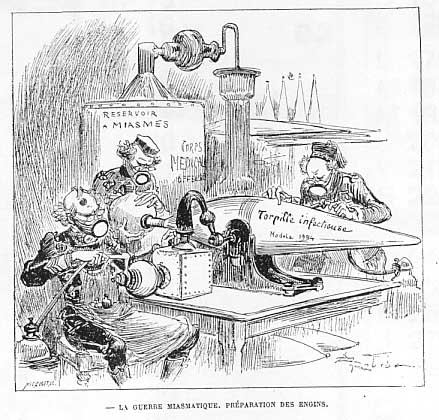
The Microbe Bomb
Robida has since been experiencing a revival of sorts in France. The Canal Plus TV channel did a special segment on his work for French television for its Year 2000 celebration:
http://www.cplus.fr/html/special/an2000/english/robida/robida_e.htm
http://www.ccf2000.com/2000_tem_gp/2000_illu_par.asp
Albert Robida, like Jules Verne, enjoyed to fantasize about the future, but his was a much more lively and tongue in cheek approach, full of humor and grotesque ideas. The illustrations were stunning in their accuracy. There it was, circa 1870, and the man had conceived of the Telephonoscope, a screen on which spectators could see events taking place at another far away location, in real time. He apparently was the first human being to conceive of television in such a specific manner. One quick look and I was hooked. I studiously flipped every page and vowed to reveal its content to an American audience hungry for historical context. There it was “microbe bombs”, “undersea tunnels”, “electric trains” and “flying cars”. There’s something to be said for actualizing our own future, and this man’s mind set the tone for the entire communications revolution a century before it actually happened. But there was a glitch in my desire to spread this revelation. Albert Robida’s work has never been reissued, and it is only available as antiquity, fetching around 8000 Francs for one of his books, or roughly $1600! So my quest had to wait awhile until I could find a way to obtain copies of some of these illustrations for myself and show them to others.
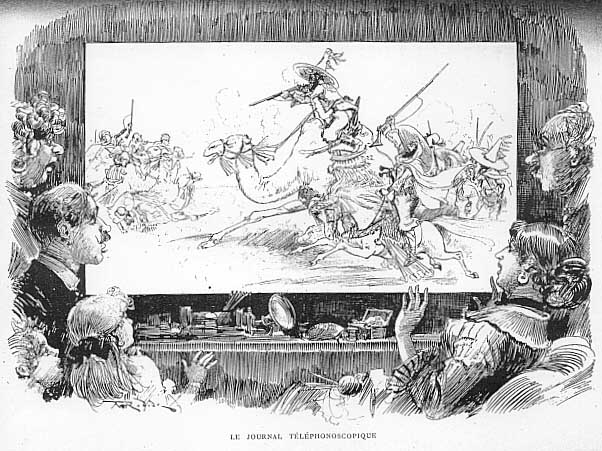
Telephonoscope
Not too long ago an association calling itself The Friends of Albert Robida was formed in France, and it is through their effort that we are now able to show you some of these astounding drawings. Leave it to the Japanese to pick up on what could be the patron saint of modernism, they have created a website, in English, for those of you who would like to learn more about this extraordinary explorer:
http://www2.gol.com/users/watinter/robidami.htm
Robida unfortunately isn’t alone. There are countless numbers of thinkers, philosophers, inventors, in France they call them writers of “anticipation”, who are now hidden from public view, gathering dust on library shelves only as valuable collector’s items. Restored to their proper context, they could assist us in developing a better future for ourselves. One other such forgotten French scientific mind was Gustave Le Bon who a researcher familiar to WEX readers, Gerry Vassilatos, has written about in his book: “Secrets Of Cold War Technology”. Gerry spends hours bent over crusty volumes in obscure libraries to unearth the truth they bring. Le Bon wrote about the nature of mass which, in retrospect, could not have been understood until the advent of quantum mechanics. Yet, the only way to obtain copies of his work is to go to the Biblioteque National in Paris and request photocopies of the original edition.
The only institution in America, which caters to this kind of inquiry, is the Bakken Museum in Minneapolis, funded by Medtronics, the artificial heart company. The Museum has long been supervised by members of the US Psychotronics Association and is extremely open to the ideas brought forth by the readers of WEX. The Bakken is dedicated to the study of electricity in life and houses original manuscripts from the likes of Tesla, Faraday, Galvani, etc… The approach of these pioneers didn’t segregate between the divine spark and electricity as a simple motor force. Their holistic understanding of energy preceded our modern comprehension of the importance between electrical brain function and health; just as Mary Shelley’s Frankenstein did in her fictitious awakening of intelligence from a lighting strike.
There’s a little booklet on my shelf published by Steven Elswick of Exotic Research, “The Letter of Petrus Peregrinus”. This letter, dated August 1269, describes how to build a compass over a hundred years before it was officially invented. Authors Lynn Picknett & Clive Prince credits Leonardo da Vinci with the invention of the bicycle in their book “The Templar Revelation”. Describing his design, which only came to light in 1960, they say: “The da Vinci roadracer had two wheels of equal size and a chain and a gear mechanism.” They also claim da Vinci created the Shroud of Turin, which would have him invent photography, nearly half a millennium before Daguerre in 1839.
The point obviously, and one made very well by Peter Lemesurier in his new book “Gods Of The Dawn”, is that it’s not the invention of a scientific idea that changes human lives, but its application. Peter says on page 168: “The Greeks, in the person of Hero of Alexandria, were already successfully using a combination of steam power and jet propulsion by around the second century of our era, even if as yet only (as some believe) for opening and closing temple doors. Had not the heavy, stultifying hand of imperial Rome descended on them and choked off all further progress, Renaissance science might have taken wing a thousand years earlier than it did, the industrial revolution might have taken place by the time of Alfred the Great, and man might have been walking on the moon before the Norman conquest.”
Perhaps had Robida’s work not been discounted in its day as mere flights of fancy by an overproductive imagination, and relegated to disposable cartoon art of the epoch, we’d have had TV, maybe even Web TV, and sadly biological warfare, generations before they materialized in real life.
The Friends of Albert Robida can be reached by mail through Jean-Claude Viche, 25 rue François Debergue, 78170 La Celle-St-Cloud France or by email through Claude Rebeyrat at claude.rebeyrat@wanadoo.fr Their newsletter is called appropriately “Telephonoscope”. Their wonderful new website is at: http://robida.free.fr
A detailed biography of Robida can be found in Philippe Brun’s book “A. Robida - Sa Vie, Son Oeuvre” available from Le Collectioneur Français, 10 rue du Pont-Louis Philippe, 75004 Paris Tel: 011-33-1-42-78-04-17 The price is around 600 Francs, or $120.
Another book was published in 1980 but is out of print: “Robida Fantastique et Science Fiction” in Pierre Horay’s “Les Maitres du Dessin Satirique” series. (I’m seeking a used copy)
Hopefully this article, and others like it, will convince a publishing house to reprint Robida’s titles in an affordable and accessible form. “La Vie Electrique” (The Electrical Life) is a mind blowing experience. If present science fiction is as prophetic of things to come as this book was, I’m joining the Y2K survivalists who are making the Real Goods mail order catalog company the hottest new stock on Wall Street!

Visions of the future at the dawn of what is today considered as technological age bring to mind Jules Verne, author of popular adventure novels such as A Journey to the Center of the Earth, Twenty Thousand Leagues Under the Sea and Around the World in Eighty Days. Less well known – but even more remarkable – is an artist incredibly talented and visionary, lived in the second half of the nineteenth century: Albert Robida.
Fanciful French writer, brilliant caricaturist, and weird illustrator, Robida was known within his contemporaries for his Voyages très extraordinaires de Saturnin Farandoul,(solipsistic adventurer of the seas grown up in a monkeys colony) and the trilogy of futuristic novels Le Vingtième Siècle, La Guerre au vingtième siècle, La vie électrique. In them we can find pioneristic intuitions about the practices of modern warfare, like robotic missiles and poison gas, but also intuitions related to technological changes through the use of telephonescope, smart instrument for continuus viewing of moving pictures and terrific precursor of modern LCD television screens.
Inspirator of Méliès’ movies and inspired by Grandville’s opera – from which he gets the zoomorphic blend – Robida carries us in a dimension always balanced between imaginative power and realism.
Robida’s universe is the sky, where we can find suspended stilt houses spinning in space, flying ships that fill crowded horizons and fabulous cities without roads any roads where strong sci-fi elements multiply themselves coexisting.
A peculiar characteristic in his works is the attention given to the practical application of inventions proposed and their social consequences. Embodying the ideal of a prophet of the pseudo-science Robida makes us dream about the future, which has already gone.
text by Luna Todaro
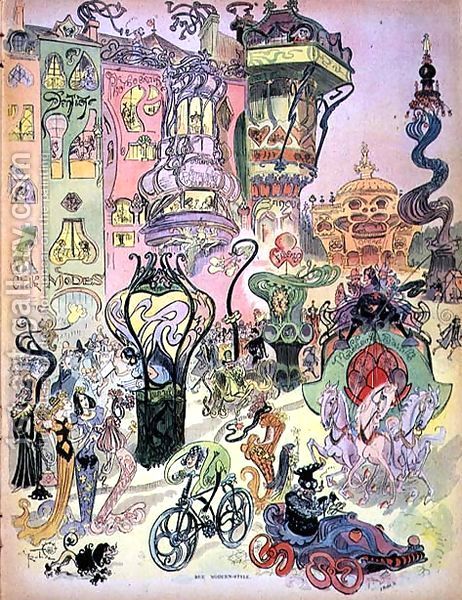
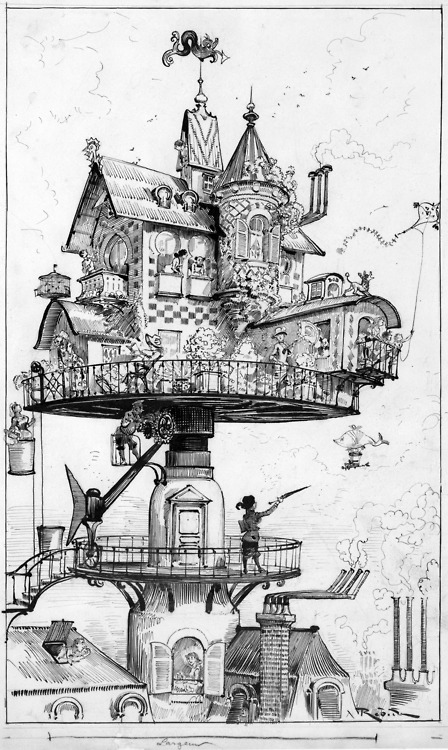
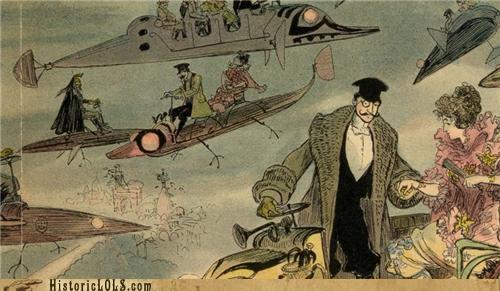

Nema komentara:
Objavi komentar